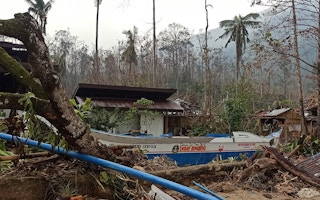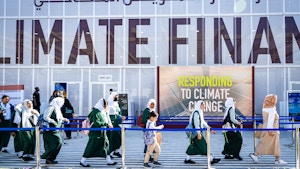Southeast Asia is on the frontlines of climate risk, with typhoons set to be more intense and floods more frequent as the Earth warms.
But at the COP27 climate summit in Sharm El-Sheikh, Egypt, only three of nine leaders from the region who spoke called for loss and damage in their speeches, delivered at the high-level plenary sessions.
Representatives from Cambodia, Philippines and Timor Leste mentioned loss and damage in their national statements. The issue was absent in the statements of Brunei, Indonesia, Laos, Malaysia, Singapore and Thailand.
Officials from Vietnam did not speak at the high-level segments of the summit; neither the military administration from Myanmar nor its civil National Unity Government, locked in a bitter conflict since the 2021 coup, made it to COP27.
The omission of the issue is in stark contrast to how calls for loss and damage, with strong undertones of liability and climate justice, have grown increasingly loud among small island states and from Africa. The debate centred on climate reparations for developing countries, which have had to deal with punishing climate disasters in recent years that they played little part in causing, has dominated the COP27 forum.
The thorny issue was added to the official COP agenda when the summit opened last week.
“[Rich nations] must provide plans for loss and damage finance. We stand at the brink. There is the danger of pushing developing countries into collapse,” said Fidelis Magalhaes, president of Timor-Leste’s council of ministers and the country’s extraordinary envoy, on Tuesday.
Timor-Leste is part of the Alliance of Small Island States, which as a bloc has lobbied hard for a dedicated loss and damage fund. Singapore is also part of the same alliance.
Ezzedin Tago, Philippines’ ambassador to Egypt, said it was an “imperative” that a “predictable system” of financial and technical support to address loss and damage is developed. The system should address impacts arising from both extreme weather and slow-onset events, like the rise in global temperatures and sea levels, Tago said.
Cambodia’s environment minister Say Samal, at the same session, said the inclusion of finance for loss and damage in the COP27 agenda is “welcomed”.
“We do hope that rapid progress can be made to deliver financing on the ground for most affected countries,” Samal said.
Other Southeast Asia countries did mention the climate risks they face – Brunei said key strategic areas of the country could be underwater in 2050. Malaysia invoked its record year-end floods in 2021, which killed over 50 people and set the country back US$1.4 billion. Many leaders called for climate finance in general.
Some countries used the speech to showcase their climate efforts – such as reforestation in Indonesia, development of the domestic electric car industry in Thailand and a national hydrogen fuel strategy in Singapore.
“The call for loss and damage finance highlights the interconnected importance of addressing both climate change and global inequality, so it is truly disappointing that Southeast Asian leaders chose not to engage with this issue,” said Dr Prapimphan Chiengkul, a climate change expert and visiting fellow at Singapore’s ISEAS – Yusof Ishak Institute.
“Southeast Asia is one of the regions that will be harshly affected by climate change and so instead of ‘playing it safe’ – only calling for additional mitigation and adaptation support – Southeast Asian leaders should be more assertive in protecting their people’s self-interests,” Chiengkul said.
Taylor Dimsdale, programme director for risk and resilience at London-based think-tank E3G, said countries most vocal on loss and damage are small island developing states and the least developed countries. Many countries in Southeast Asia do not fall into either category, Dimsdale said.
Cambodia, at COP27, also appears to want to shake off the image of a developing nation, despite having one of the lowest per-person gross domestic product in the region.
“Thanks to peace, political stability and sustained economic growth over the last two decades, Cambodia is embarking towards a middle class society,” Samal said during his national statement.
Sandeep Chamling Rai, a senior advisor at environmental group WWF-International, pointed out that Southeast Asian countries are part of larger regional blocs that are pushing the loss and damage agenda at COP27.
All 10 countries within the Association of Southeast Asian Nations are part of the United Nations G77 bloc of developing states. Rai said he is not worried that some Southeast Asian members are not calling for loss and damage financing publicly, since the G77’s stance represents each of their positions.
On Tuesday (15 November), G77 called for the creation of a dedicated fund for loss and damage, and for a committee overseeing the fund to be created by this year. How the fund works should be decided by COP28, to be held in Dubai at the end of 2023, the bloc said in a draft text.
The G77 proposal comes after developed countries had proposed looser timelines and pointed to other sources of finance last week. Under a consensus agreement, countries have to come to a decisive conclusion on loss and damage financing by 2024.
“We will have to see how the negotiations move forward on this,” Rai said. COP27 is slated to wrap up on Friday, 18 November.





















